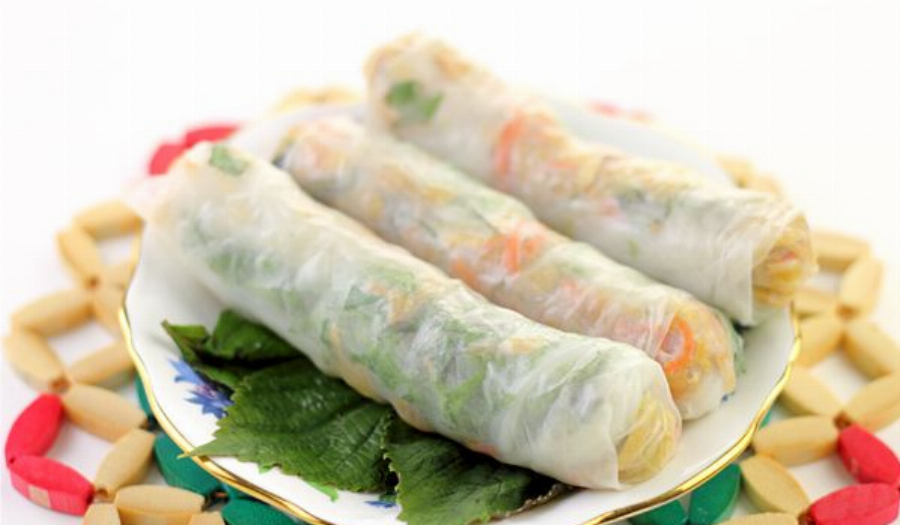For this dish I made a traditional bì chay with jicama, tofu, a protein element and soy sauce dipping sauce. Then I wrapped the tofu mixture in rice paper disks, forming tasty and healthy spring rolls. Rice vermicelli noodles, shredded lettuce and cucumber were added to form the rolls as well.
Once you master forming the spring rolls, you can experiment with many different combinations of noodles, vegetables and protein. Just try to maintain the same ratio of ingredient types as in this recipe.
1. Info for Vegetarian Spring Rolls: Bi Cuon Chay Recipe
- Cook Time: 15 mins
- Total Time: 45 mins
- Servings: 10
- Calories: 222 kcal
2. Ingredients for Vegetarian Spring Rolls: Bi Cuon Chay Recipe
- 3 (12-ounce) packages firm tofu
- 1 large jicama
- 2 pounds taro root
- 6 Yukon Gold potatoes
- 3 white sweet potatoes
- 1¼ cups canola oil (or any neutral oil), as needed
- 1¼ cups jasmine rice or thinh (check tip section)
- 1 tablespoon mushroom seasoning salt (or regular salt)
- 2 carrots, peeled and shredded into about 5″-long thick strips
- 1 shallot, thinly sliced
- 2 yellow onions (see tips), sliced and fried
- 1 (2-ounce) package dried bean thread noodles
- 2 teaspoons salt
- ¼ teaspoon red chili powder
- 1 teaspoon black pepper, freshly cracked
- 1¼ tablespoons superfine sugar (or granulated sugar)
- 1 (16-ounce) package rice vermicelli noodles, boiled and drained
- 20 bánh tráng disks (rice paper, see tips)
- 1 large cucumber
- ¼ cup Vietnamese mint, chopped
- ¼ cup Vietnamese pickled spring onions (see tips), drained and thinly sliced
- 2 tablespoons cilantro, chopped
- 4 cups iceberg lettuce, shredded
- 6 sprigs tía tô, see tips
- ¼ cup Thai basil, chopped
3. Directions:
- For the dry roasted rice powder: Dry roast the jasmine rice in a pan over the stove. Stir the rice using chopsticks until the grains turn a rich brown color (for about 5-7 minutes over high heat). Let cool. Grind the grains into a fine powder using a food processor or spice grinder. I use the VitaMix Dry Blade Container. The result should be a fine mill.
- For the dried bean thread noodles: Place the whole package of dried bean thread noodles in a bowl. Don’t forget to cut the little threads and discard them! Soak the noodles in lukewarm water for 30 minutes (up to 1 hour, depending on the bean thread noodle brand), then drain. Chop into 1″ threads. The texture should be soft but not soggy.
- For the tofu: Drain any liquid from the tofu. Pat dry with a paper towel. Slice the tofu into ½”-thick pieces. In a large pan, heat about 2 tablespoons of oil; fry the tofu slices and transfer to a plate. Once the tofu is cool enough to handle, cut the pieces into very thin strips. For the jicama: Peel and slice horizontally into ½”-thick pieces. In the same large pan, add about 1 tablespoon oil and fry the jicama slices until golden brown. Once they’re cool enough to handle, cut the pieces into very thin strips.
- For the carrot: In a large pan, heat 1 tablespoon oil. Add the shallot and cook until golden. Add the carrots and drizzle with 2-3 tablespoons water. Stir-fry until softened. Season with salt and pepper.
- For the taro and potatoes: Peel and shred the taro using a mandoline. Place in a large bowl. Fill the bowl with ice water (it should barely cover the taro root). Let sit for about 15 minutes, then drain all the liquid. Pat dry.
- Repeat the same procedure with the sweet and regular potatoes.
- In the same large pan, add about 2 more tablespoons of oil. Sprinkle about 4-5 tablespoons taro (working in several batches) evenly into the pan. Do not stir. Wait for at least 2 minutes until one side is nicely fried, crisp and golden. Flip the taro using chopsticks. Continue until all the taro is fried and repeat the same procedure with the potatoes. Add more oil if necessary.
- When the taro and potatoes are nicely fried and golden, transfer to a platter lined with paper towels. As soon as all the oil has be absorbed, transfer them to a large bowl.
- Making bì chay: In a large mixing bowl, combine the jicama, bean thread noodles and 2-3 tablespoons roasted rice powder. Toss until combined. Add the fried taro, potatoes, sweet potatoes and tofu. Season with mushroom powder. Sprinkle with sugar. Adjust seasoning with salt, chili powder and black pepper. Toss well, then sprinkle with more roasted rice powder. Add the carrots and fried onions. Mix well.
- Prepping the cucumbers: Cut the cucumbers in half lengthwise and use a spoon to remove the seeds. Layer a cooling rack on top of a cookie sheet, and place the cucumbers on top. Sprinkle with salt on both sides and let sit for 1 hour. Pat dry with a kitchen towel. Cut the cucumbers into ¼ to ½-inch thick matchsticks. Set aside.
- Fill a saucepan with water. Bring the water to a boil. Let cool a bit. Quickly dip the rice papers, one at a time, into the warm water and place on a clean flat surface. Wait about 1 or 2 minutes. The rice paper should be soft but not too wet. I usually dip 4 rice papers at a time, then start wrapping.
- Place 2 leaves of mint, tía tô and basil, 1 sprig cilantro, a bit of pickled spring onion, 3-4 cucumber “matchsticks”, the same amount of shredded lettuce in the center and about 1½-2 tablespoons bì chay, about 1½” from the bottom edge of the rice paper.
- Carefully fold each side flap and roll away from you. If the rice paper is moistened properly, it should easily stick and roll. Tuck all the mixture into the wrapper, forming a cigar. Continue until all the rice papers disks are used.
- Serve with peanut dipping sauce (recipe follows).
- Bon appétit!

